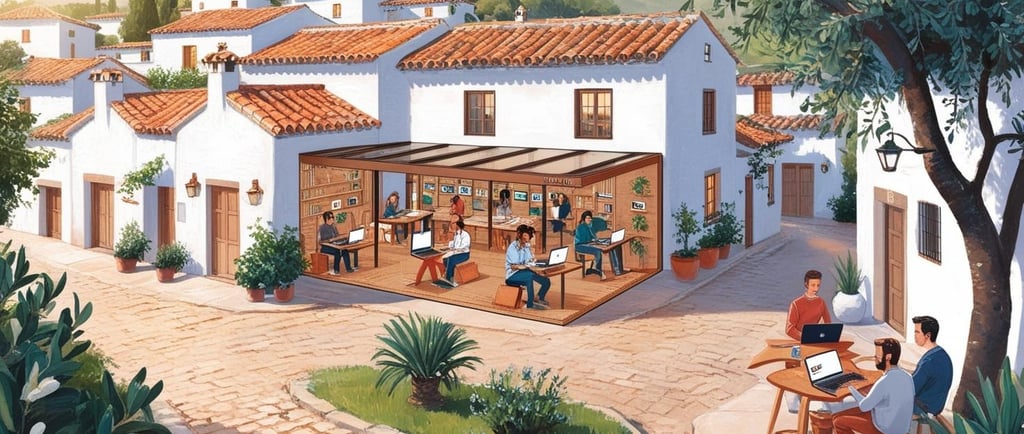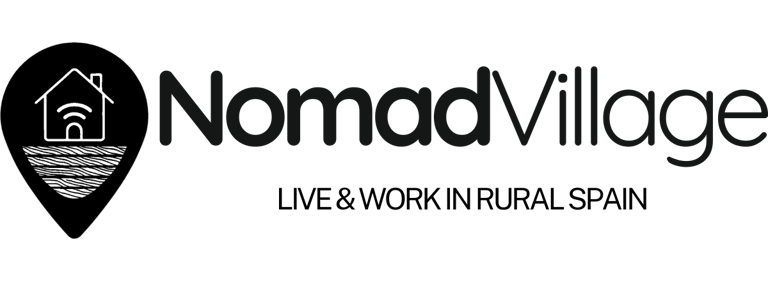Remote Work Infrastructure: How Partner Villages Are Adapting
Discover how Spanish villages are investing in high-speed internet, coworking spaces, and remote work-friendly housing to attract digital nomads and boost the local economy.
3/18/20253 min read


Digital nomadism is no longer a concept of the future—it is a global reality. With the rise of remote work, many professionals are looking for locations that offer the right infrastructure to live and work away from major urban centers.
To meet this demand, NomadVillage partner villages are investing in remote work infrastructure, ensuring fast internet, well-equipped coworking spaces, and housing adapted to digital nomad needs. But what are the key changes taking place in these communities? And how are these investments impacting the local economy?
Let’s explore how villages are transforming into ideal remote work hubs and why this shift benefits both remote workers and local communities.
1. Fast and Reliable Internet: The First Step to Attracting Digital Nomads
Connectivity is one of the most crucial factors for any remote professional. Without a stable, high-speed internet connection, a village is unlikely to attract digital nomads.
How Are Partner Villages Improving Connectivity?
✔ Installation of fiber optic networks and 5G in strategic areas.
✔ Partnerships with internet providers to ensure affordable and high-quality plans.
✔ Expansion of free Wi-Fi coverage in public spaces and coworking hubs.
These investments don’t just benefit digital nomads—they also improve the lives of local residents, who gain access to essential digital services such as online education, telemedicine, and remote job opportunities.
2. Rural Coworking Spaces: Work with Structure and Community
Not all digital nomads want to work alone at home. Many prefer collaborative environments where they can network, exchange knowledge, and enhance productivity.
What Do New Coworking Spaces Offer?
✅ Meeting rooms equipped for video conferences and presentations.
✅ Individual and shared workstations with ergonomic furniture.
✅ High-speed, redundant internet to prevent connectivity issues.
✅ Common areas for networking, events, and knowledge sharing.
✅ Cafeterias and social spaces to foster interaction.
The creation of rural coworking spaces not only attracts digital nomads but also provides local entrepreneurs, students, and freelancers with a professional work environment.
3. Remote Work-Ready Rural Homes
Beyond coworking spaces, many nomads prefer a quiet, private workspace at home. To accommodate this, property owners and villages are adapting rural homes to meet remote work demands.
How Are These Homes Being Upgraded?
✔ Dedicated home office space with ergonomic furniture and proper lighting.
✔ High-speed internet coverage throughout the house, ensuring uninterrupted connectivity.
✔ Comfortable and well-designed environments that promote productivity and well-being.
✔ Sustainability and energy efficiency, with solar energy and resource reuse.
This type of adapted housing ensures that digital nomads can work comfortably and efficiently, while also enjoying a better quality of life in rural villages.
4. Investments in Mobility and Transportation
For rural villages to truly attract remote workers, accessible transportation is essential. Many digital nomads travel frequently and need good connections to airports and major cities.
How Are Villages Improving Mobility?
✅ Expansion of public transport routes, connecting villages to nearby cities.
✅ Promotion of bicycles and sustainable transport options.
✅ Partnerships with ride-sharing services and vehicle rentals.
✅ Upgraded regional airports to accommodate international remote workers.
These improvements allow digital nomads to travel more conveniently while maintaining a stable remote work routine.
5. Smart Tourism and Cultural Experiences
Beyond work, one of the main attractions for digital nomads is the chance to experience new cultures. Many NomadVillage partner villages are developing smart tourism, focusing on integrating remote workers into local traditions.
What Initiatives Are Being Developed?
✔ Workshops and cultural events, such as cooking classes, wine tastings, and artisan crafts.
✔ Eco-trails and outdoor activities, promoting a healthy, nature-connected lifestyle.
✔ Community involvement programs, allowing nomads to participate in local volunteer projects.
✔ Regional festival calendars, encouraging visitors to immerse themselves in local culture.
This form of sustainable tourism not only attracts digital nomads but also strengthens village identities, preserves traditions, and creates new economic opportunities for residents.
Conclusion: Smart Villages and the Future of Remote Work
Remote work is reshaping how we live and work. The NomadVillage partner villages are adapting to this new reality by investing in high-speed internet, coworking spaces, work-friendly homes, and a balanced lifestyle to attract professionals from around the world.
By choosing one of these villages as a remote work base, digital nomads gain an ideal environment for productivity while also contributing to the sustainable development of local communities.
If you’re looking for an inspiring place to live and work remotely, explore the available destinations at NomadVillage.es and find your next location!
NomadVillage
Live & Work in Rural Spain
Connecting digital nomads with rural villages
contact
Subscribe to Stay Connected
+34 600 123 456
© 2025. All rights reserved.
